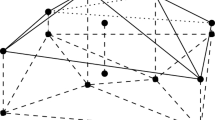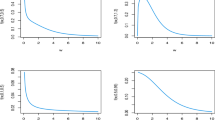Abstract
In this paper we derive some exact tests and one conservative test for a common location parameter μ of several independent truncated exponential distributions with different scale parameters. Tests for μ = μ0 against two-sided alternatives are suggested based on suitable combinations of natural pivots. The exact tests are based on non-minimal sufficient statistics while the conservative test is based on minimal sufficient statistics. Expressions for local power for alternatives μ > μ0 are derived and compared. It turns out that the power for alternatives μ < μ0 is the same for all proposed exact tests. We observe that the test based on a combination of inverse normal cdf of P-values is locally best in most cases. The performance of the conservative test is indeed remarkable in large samples. Some interesting features of a familiar test in the case of one population are also pointed out.

Similar content being viewed by others
References
Fisher, R. (1932). Statistical methods for research workers, edn. 4, 307 pp., illus. Edinburgh and London.
Ghosh, M. and Razmpour, A. (1984). Estimation of the common location parameter of several exponentials. Sankhyā: The Indian Journal of Statistics, Series A, 383–394.
Lipták, T. (1958). On the combination of independent tests. Magyar Tud Akad Mat Kutato Int Kozl 3, 171–197.
Pal, N. and Sinha, B. (1990). Estimation of a common location of several exponentials. Statistics & Decisions 8, 27–36.
Stouffer, S.A., Suchman, E.A., DeVinney, L.C., Star, S.A. and Williams, R.M. Jr (1949). The American Soldier: Adjustment During Army Life, I. Princeton University Press, Princeton.
Acknowledgments
Bimal K. Sinha is thankful to Dr. Tommy Wright at the US Census Bureau for helpful comments and encouragement. We also thank Dr. Nabendu Pal for referring us to the excellent 1984 paper by Ghosh and Razampour. Our sincere thanks are also due to a reviewer for some helpful comments.
Author information
Authors and Affiliations
Corresponding author
Additional information
Publisher’s Note
Springer Nature remains neutral with regard to jurisdictional claims in published maps and institutional affiliations.
Appendix I: Proof of Eq. 31
Appendix I: Proof of Eq. 31
That U is independent of (T1,⋯ ,Tk) follows from a direct appeal to Basu’s theorem upon noting that for any fixed (σ1,⋯ ,σk), U is complete for μ, (T1,⋯ ,Tk) has a joint distribution which is free from μ. To derive the joint distribution of (T1,⋯ ,Tk), we write
and note that W1,⋯ ,Wk are independently distributed with \(\frac {W_{i}}{\sigma _{i}} \sim Gamma\) (ni − 1),i = 1,⋯ ,k, and W1,⋯ ,Wk,U1,⋯ ,Uk are all mutually independent. Then
where
Note that
Also, from Ghosh and Razmpour (1984), it follows that
Hence, conditional on Ui > Uj,
Combining (8.4), (8.5) and (8.6), we get
The result follows since \( \frac {W_{j}} {\sigma _{j}} \sim Gamma(n_{j} -1) \).
Rights and permissions
About this article
Cite this article
Kifle, Y.G., Sinha, B.K. Comparison of Some Exact Tests for a Common Location Parameter of Several Truncated Exponential Distributions with Different Scale Parameters. Sankhya B 83 (Suppl 1), 36–64 (2021). https://doi.org/10.1007/s13571-021-00254-1
Received:
Accepted:
Published:
Issue Date:
DOI: https://doi.org/10.1007/s13571-021-00254-1




